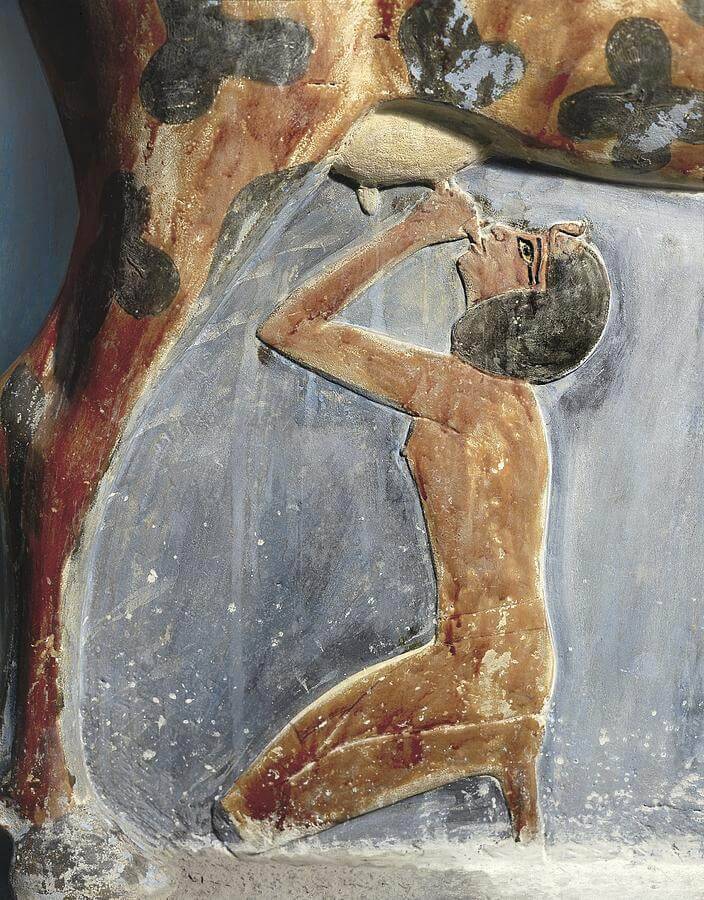Egypt came first, then history and civilization came. Egypt has one of the world's seven wonders of the pyramids. The Virgin Mary came to protect herself and her son. Egypt is the safest destination for tourism. My goal is to help foreigners learn my country’s history, come to Egypt, whatever your budget, and I will be your guide at no additional cost to you. booking with us. The goal is to service booking tours to Egypt. the best Nile cruise in Egypt. https://kingofegypttours.com
Tuesday, 17 November 2020
Shrine of the Goddess Hathor.
This shrine and the cow’s statue were retrieved from under heaps of debris south of the Mortuary Temple of Hatshepsut at Deir el-Bahari. The shrine is from the reign of Thutmose III. Its roof is painted blue with yellow stars to imitate the Vault of Heaven.
The statue of Hathor as the divine cow, in the middle of the shrine, is inscribed for Amenhotep II, Thutmose III’s son and successor. Hathor’s head is surmounted by a uraeus, a solar-disc, and two short plumes. Amenhotep can be seen twice in the statue: once at the front beneath the cow’s head, and a second time depicted as a young boy nursing beneath the cow’s right side.
New Kingdom, mid 18th Dynasty, reign of Thutmose III, ca. 1479-1425 BC. Now in the Egyptian Museum, Cairo.
Shawabty of King Taharqa.
This is a shawabty belonging to King Taharqa.The figure wears a bulging bag (khat) headdress with uraeus and has a long beard. There are ten horizontal lines of incised unframed text on the front of body, it does not extend to the back of the figure. This mummiform shape does not have a back pillar or base. Here the hands are opposed resting on the chest.In each hand the figure holds a hoe and a cord to a small bag slung over each shoulder. The hoe on the right has a narrow blade and the one on left has a broad blade.
Sphinx Sculpture Uncovered in Egypt.
That a sandstone sphinx measuring about 15 inches tall was discovered during work to reduce groundwater levels at the pharaonic temple of Kom Ombo, which was constructed by Ptolemy VI in honor of the twin gods Sobek and Haroeris. According to Egypt's antiquities ministry, the statue was found in the same area of the temple where two sandstone reliefs of King Ptolemy V were previously unearthed. The sphinx is thought to date to the Ptolemaic era, between 305 and 30 B.C. For more on the Ptolemaic era in Egypt, go to “In the Time of the Rosetta Stone.”
GOOD MORNING FROM EGYPT EGYPT READY NOW مصر مستنياك
GOOD MORNING FROM EGYPT EGYPT READY NOW مصر مستنياك http://kingofegypttours.com/ Egipto te espera http://kingofegypttours.com/ Egypt is wa...

-
Cairo is fan-shaped, narrowest in the south, where the river valley is wedged between desert escarpments, and widest in the north, where t...
-
Abu Simbel, the site of the two temples built by the Egyptian king Ramses II (reigned 1279-13 BC), which is now located in Aswan Govern...
-
GOOD MORNING FROM EGYPT EGYPT READY NOW مصر مستنياك http://kingofegypttours.com/ Egipto te espera http://kingofegypttours.com/ Egypt is wa...













